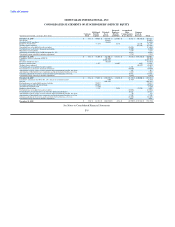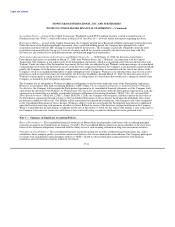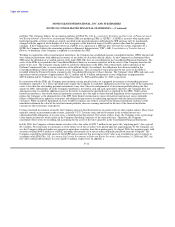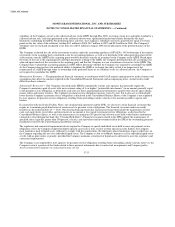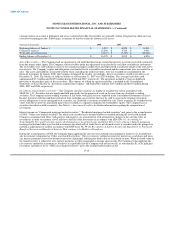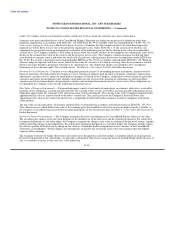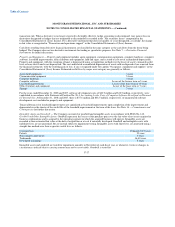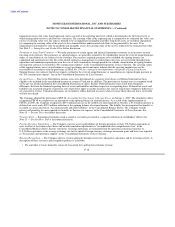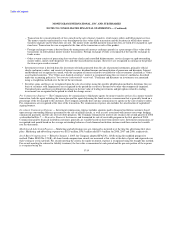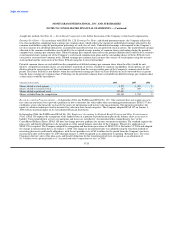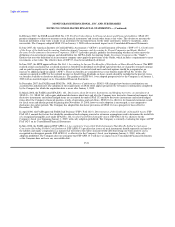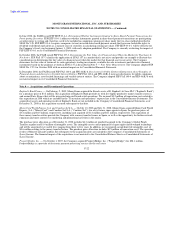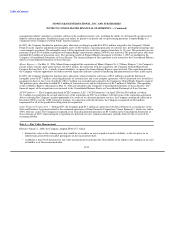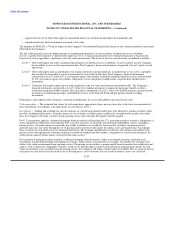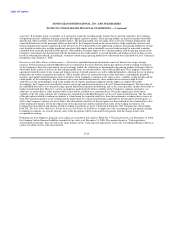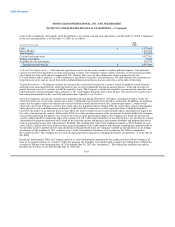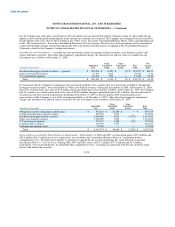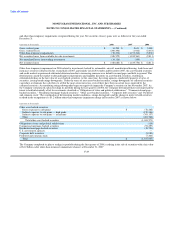MoneyGram 2008 Annual Report Download - page 105
Download and view the complete annual report
Please find page 105 of the 2008 MoneyGram annual report below. You can navigate through the pages in the report by either clicking on the pages listed below, or by using the keyword search tool below to find specific information within the annual report.
Table of Contents
MONEYGRAM INTERNATIONAL, INC. AND SUBSIDIARIES
NOTES TO CONSOLIDATED FINANCIAL STATEMENTS — (Continued)
– Transaction fees consist primarily of fees earned on the sale of money transfers, retail money orders and bill payment services.
The money transfer transaction fees vary based upon the face value of the transaction and the locations in which these money
transfers originate and to which they are sent. The money order and bill payment transaction fees are fixed fees charged on a per
item basis. Transaction fees are recognized at the time of the transaction or sale of the product.
– Foreign exchange revenue is derived from the management of currency exchange spreads (as a percentage of face value of the
transaction) on international money transfer transactions. Foreign exchange revenue is recognized at the time the exchange in
funds occurs.
– Other revenue consists of processing fees on rebate checks and controlled disbursements, service charges on aged outstanding
money orders, money order dispenser fees and other miscellaneous charges. These fees are recognized in earnings in the period
the item is processed or earned.
• Investment revenue is derived from the investment of funds generated from the sale of payment instruments, primarily official
checks and money orders, and consists of interest income, dividend income and amortization of premiums and discounts. Interest
and dividends are recognized as earned, with the exception of interest related to available-for-sale investments classified as "Other
asset-backed securities." For "Other asset-backed securities," interest is recognized using the cost recovery method as described
under the accounting policy for "Investments (substantially restricted)." Premiums and discounts on investments are amortized
using a straight-line method over the life of the investment.
• Securities gains and losses are recognized upon the sale of securities using the specific identification method to determine the cost
basis of securities sold. Impairments are recognized in the period the security is deemed to be other-than-temporarily impaired.
Unrealized gains and losses resulting from changes in the fair value of trading investments and put options related to trading
investments are recognized in the period in which the change occurs.
Fee Commissions Expense — The Company pays fee commissions to third-party agents for money transfer services. In a money transfer
transaction, both the agent initiating the transaction and the agent disbursing the funds receive a commission that is generally based on a
percentage of the fee charged to the customer. The Company generally does not pay commissions to agents on the sale of money orders.
Fee commissions are recognized at the time of the transaction. Fee commissions expense also includes the amortization of capitalized
signing bonuses.
Investment Commissions Expense — Investment commissions expense includes amounts paid to financial institution customers based
upon average outstanding balances generated by the sale of official checks, as well as costs associated with interest rate swaps hedging
commission payments and the sale of receivables program. The Company terminated its interest rate swaps in the second quarter of 2008
as described in Note 7 — Derivative Financial Instruments and terminated its sale of receivable program in the first quarter of 2008.
Commissions paid to financial institution customers generally are variable based on short-term interest rates. Investment commissions are
recognized each month based on the average outstanding balances of each financial institution customer and their contractual variable
rate for that month.
Marketing & Advertising Expense — Marketing and advertising costs are expensed as incurred or at the time the advertising first takes
place. Marketing and advertising expense was $52.9 million, $56.5 million and $53.4 million for 2008, 2007 and 2006, respectively.
Stock-Based Compensation — Effective January 1, 2005, the Company adopted SFAS No. 123(R) using the modified prospective
method. Under SFAS No. 123(R), all share-based compensation awards are measured at fair value at the date of grant and expensed over
their vesting or service periods. For awards meeting the criteria for equity treatment, expense is recognized using the straight-line method.
For awards meeting the criteria for liability treatment, the fair value is remeasured at each period and the pro-rata portion of the expense
is recognized using the
F-19


